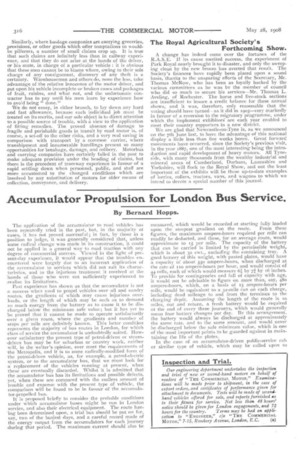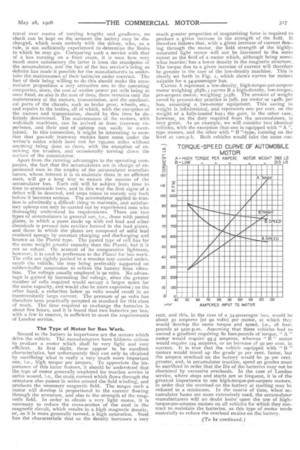Accumulator Propulsion for London Bus Service.
Page 2

Page 3

If you've noticed an error in this article please click here to report it so we can fix it.
By Bernard Hopps.
The application of the accumulator to road vehicles has :been repeatedly tried in the past, but, in the majority ot cases, it has not proved successful; in fact, by those in a position to judge, it was generally considered .that, unless some radical change was made in its construction, it could not be applied in a general way to road traction with any degree of commercial success. Viewed in the light of Fesent-day experience, it would appear that the troubles encountered were largely due to an incorrect application of the accumulator to services which did not suit its characteristics, and to the injurious treatment it received at the lands of those who were not sufficiently experienced to :realise its limitations.
Past experience has shown us that the accumulator is not .a success when used to propel vehicles over all and sundry routes, the gradients of which may cause injurious overloads, or the length of which may be such as to demand so much energy from the battery as to cause it to be discharged below the minimum safe value; but it has yet to le proved that it cannot be made to operate satisfactorily over a given route, where the gradients and number of stops per mile are definitely known. This latter condition represents the majority of bus routes in London, for which class of service the accumulator is undoubtedly suited. How-ever satisfactory the present type of petrol-driven or steam. driven bus may be for suburban or country work, neither will, in the writer's opinion, ever meet the requirements of the Metropolis, and it is to some radically-modified form of -the petrol-driven vehicle, as, for example, a petrol-electric .system, or to the accumulator bus, that we must look for -a replacement of the vehicles running at present, when these are eventually discarded. Whilst it is admitted that the accumulator bus has its limitations and possible defects, yet, when these are compared with the endless amount of trouble and expense with the present type of vehicle, the comparison will be found to be in favour of the accumulator-propelled bus.
It is proposed briefly to consider the probable conditions under which accumulator buses might be run in London service, and also their electrical equipment. The route having been determined upon, a trial bus should be put on for, say, two of the busiest days, and a careful record made of the energy output from the accumulators for each journey • during that period. The maximum current should also be measured, which would be recorded at starting fully loaded
upon the steepest gradient on the route. From these figures, the maximum ampere-hours required per mile can readily be deducted, and these, for an average route, would approximate to 15 per mile. The capacity of the battery that can be carried is limited by the permissible weight, which is about 30 cwt., excluding the containing tray. A good battery of this weight, with pasted plates, would have a capacity of about 55o ampere-hours, when discharged at the rate of Ito ampere-hours per hour, and would consist of 44 cells, each of which would measure 67, by 7 by 16 inches. To provide for contingencies and fall of capacity with age, it would not he advisable to figure on more than, say, 480 ampere-hours, which, on a basis of 15 ampere-hours per mile, would be equivalent to a 32-mile run on each charge, including dead mileage to and from the terminus to the charging depet. Assuming the length of the route is m miles, out and return, a fresh battery would be required at the end of every three journeys, which would generally mean four battery changes per day. By this arrangement, the battery would always be discharged at approximately the same rate, and to the same amount, and would never be discharged below the safe minimum value, which is one of the most important points to be guarded against in maintaining the life of the plates.
In the case of an accumulator-driven public-service cab or similar type of vehicle, which may be called upon to
travel over routes of varying lengths and gradients, no check can be kept on the amount the battery may be discharged, which rests entirely with the driver, who, as a rule, is not sufficiently experienced to determine the limits to which he may go. Comparing such a service with that of a bus running on a fixed route, it is seen how very much more satistactory the latter is from the standpoint of the accumulators, and the fact of the bus service's being so definite has made it possible for the manufacturers to undertake the maintenance of their batteries under contract. The fact of their being willing to do this should make the accumulator proposition a very attractive one to the operating companies, since, the cost of motive power per mile being at once fixed, as also is the cost of tires, there remains only the maintenance of the motors, transmission, and the mechanical parts of the chassis, such as brake gear, wheels, etc., and repairs to the bodies, all of which, with the exception of the motors and transmission, should by this time be definitely determined. The maintenance of the motors, with well-built machines, can be arrived at from tramway experience, and their cost of upkeep can easily be ascertained. In this connection, it might be interesting to mention that zoo-volt tramway motors have come under the writer's notice which have run for 250,000 miles without anything being done to them, with the exception of renewing the brushes, and occasionally turning down the surface of the commutator.
Apart from the running advantages to the operating companies, the fact that the accumulators are in charge of experienced men in the employ of the accumulator manufacturers, whose interest it is to maintain them in an efficient state, will go a long way to ensure the success of the accumulator bus. Each cell will be subject from time to time to systematic tests, and in this way the first signs of a defect will be detected, and steps taken to remedy any fault before it becomes serious. The accumulator applied to traction is admittedly a difficult thing to maintain, and satisfactory upkeep can only be carried out by experienced men who thoroughly understand its requirements. There are two types of accumulators in general use, i.e., those with pasted plates, in which a paste made up with red lead and other chemicals is pressed into cavities formed in the lead plates, and those in which the plates are composed of solid lead rendered spongy by constant charging and discharging and known as the Plante type. The pasted type of cell has for the same weight greater capacity than the Plant6, but it is not so robust. On account of its comparative lightness, however, it is used in preference to the Plant 6 for bus work. The cells are tightly packed in a wooden tray carried under_ math the vehicle, the tray being preferably supported on rubber-buffer suspension to relieve the battery from vibration. The voltage usually employed is go volts. No advantage is gained by increasing the voltage, since the greater number of cells required would occupy a larger space for the same capacity, and would also be more expensive ; on the other hand, a reduction below 90 volts would result in an inconveniently large current. The pressure of go volts has therefore been practically accepted as standard for this class of work. The time required to re-charge the batteries is about five hours, and it is found that two batteries per bus, with a few in reserve, is sufficient to meet the requirements of London service.
The Type ot Motor for Bus Work.
Second to the battery in importance are the motors which drive the vehicle. The manufacturers have hitherto striven to produce a motor which shall he very light and very efficient. At first sight, these appear to be excellent characteristics, but unfortunately they can only be obtained by sacrificing what is really a very much more important one, i.e., high torque per ampere. To appreciate the importance of this latter feature, it should be understood that the type of motor generally employed for traction service is series wound, i.e., the main, current which flows through the armature also passes in series around the field winding, and produces the necessary magnetic field. The torque such a motor will develop is proportional to the current flowing through the armature, and also to the strength of the magnetic field. In order to obtain a very light motor, it is necessary to reduce the cross-section of the steel in the magnetic circuit, which results in a high magnetic density, or, as it is more generally termed, a high saturation. Steel has the characteristic that as the density increases a very
much greater proportion of magnetising force is required to produce a given increase in the strength of the field. It therefore follows that, with a given increase of current flowing through the motor, the field strength of the highly. saturated light motor will not be increased to the sameextent as the field of a motor which, although being somewhat heavier; has a lower density in the magnetic structure. The torque due to a given increase of current will thereforebe greater in the case of the low-density machine. This is clearly set forth in Fig. r, which shows curves for motors suitable for a 34-passenger bus. Curves A represent a low-density, high-torque-per-ampere motor weighing 3851b. ; curves B a hig,h-density, low-torque_ per-ampere motor, weighing 315lb. The amount of weight saved by present-day practice is 7olb. per motor or 14o1b. per bus, assuming a two-motor equipment. This saving in weight is infinitesimal, and represents one per cent. on theweight of a fully-loaded bus ; the gain, in the other case, however, on the duty required from the accumulators, is very great. As an example, we will consider two identical vehicles, with the exception that one is equipped with "A type motors, and the other with " B "-type, running on the level at 12m.p.h. Both vehicles would take the same cur
rent, and this, in the case of a 34-passenger bus, would beabout so amperes (at go volts) per motor, at which they would develop the same torque and speed, i.e., 28 footpounds at 92or.p_m. Assuming that these vehicles had toascend a gradient requiring 8o foot-pounds of torque, "A " motor would require 95.5 amperes, whereas "B " motor would require 124 amperes, or an increase of 30 per cent. in current. It is true that the vehicle equipped with "B motors would travel up the grade 30 per cent. faster, but the ampere overload on the battery would be 30 per cent. greater, and, in accumulator traction, speed on grades must be sacrificed in order that the life of the batteries may not beshortened by excessive overloads. In the case of London service, where stops and starts are so frequent, it is of the greatest importance to use high-torque-per-ampere motors, in order that the overload on the battery at starting may be reduced to a minimum. In the course of time, when accumulator buses are more extensively used, the accumulatormanufacturers will no doubt insist upon the use of hightorque-per-ampere motors on all vehicles for which they contract to maintain the batteries, as this type of motor tends materially to reduce the overload strains on the battery.




















